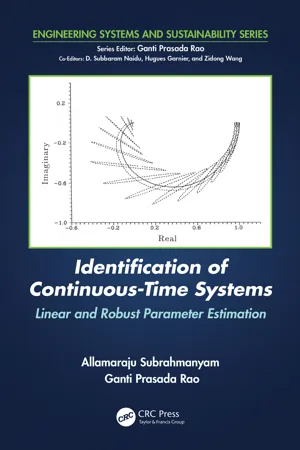
Identification of Continuous-Time Systems
Linear and Robust Parameter Estimation
- 120 pages
- English
- ePUB (mobile friendly)
- Available on iOS & Android
Identification of Continuous-Time Systems
Linear and Robust Parameter Estimation
About This Book
Models of dynamical systems are required for various purposes in the field of systems and control. The models are handled either in discrete time (DT) or in continuous time (CT). Physical systems give rise to models only in CT because they are based on physical laws which are invariably in CT. In system identification, indirect methods provide DT models which are then converted into CT. Methods of directly identifying CT models are preferred to the indirect methods for various reasons. The direct methods involve a primary stage of signal processing, followed by a secondary stage of parameter estimation. In the primary stage, the measured signals are processed by a general linear dynamic operation—computational or realized through prefilters, to preserve the system parameters in their native CT form—and the literature is rich on this aspect.
In this book: Identification of Continuous-Time Systems-Linear and Robust Parameter Estimation, Allamaraju Subrahmanyam and Ganti Prasada Rao consider CT system models that are linear in their unknown parameters and propose robust methods of estimation. This book complements the existing literature on the identification of CT systems by enhancing the secondary stage through linear and robust estimation.
In this book, the authors
-
- provide an overview of CT system identification,
-
- consider Markov-parameter models and time-moment models as simple linear-in-parameters models for CT system identification,
-
- bring them into mainstream model parameterization via basis functions,
-
- present a methodology to robustify the recursive least squares algorithm for parameter estimation of linear regression models,
-
- suggest a simple off-line error quantification scheme to show that it is possible to quantify error even in the absence of informative priors, and
-
- indicate some directions for further research.
This modest volume is intended to be a useful addition to the literature on identifying CT systems.
Frequently asked questions
Information
1
Introduction and Overview
1.1 Background
Table of contents
- Cover
- Half Title
- Series Page
- Title Page
- Copyright Page
- Table of Contents
- List of Figures
- List of Tables
- Preface
- Acknowledgments
- Authors
- List of Abbreviations
- 1. Introduction and Overview
- 2. Markov Parameter Models
- 3. Time Moment Models
- 4. Robust Parameter Estimation
- 5. Error Quantification
- 6. Conclusions
- Bibliography
- Subject Index
- Author Index